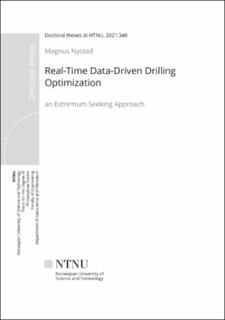| dc.contributor.advisor | Pavlov, Alexey | |
| dc.contributor.advisor | Hovda, Sigve | |
| dc.contributor.advisor | Aadnøy, Bernt Sigve | |
| dc.contributor.author | Nystad, Magnus | |
| dc.date.accessioned | 2021-12-01T13:01:26Z | |
| dc.date.available | 2021-12-01T13:01:26Z | |
| dc.date.issued | 2021 | |
| dc.identifier.isbn | 978-82-326-6290-6 | |
| dc.identifier.issn | 2703-8084 | |
| dc.identifier.uri | https://hdl.handle.net/11250/2832368 | |
| dc.description.abstract | Drilling a well for exploration or production of petroleum resources is a costly and complicated procedure. There is a great potential for cost reduction by drilling safer, faster and with less Non-Productive Time (NPT). Reducing the time spent on drilling will not only save costs, it also provides the benefit of lowering the environmental impact of drilling operations.
From a mechanical standpoint, achieving high efficiency drilling can be realized by optimizing the applied Weight on Bit (WOB) and drillstring rotational speed (Revolutions per Minute - RPM). However, selection of optimal values for WOB and RPM is a complex task. The drilling action at the bit happens at distances often several kilometers away from the rig, and only indirect measurements performed at the surface are routinely available to gauge what is happening down the hole. The task is further complicated by uncontrollable changes in downhole conditions such as variations in rock properties and wear and tear on the bit, which can alter the bit/rock interaction so that the WOB and RPM that was optimal a few minutes ago might no longer be the most efficient solution. Furthermore, the information required to accurately model the downhole conditions might not be directly measurable or available in real-time, which could preclude available models from predicting the optimal WOB and RPM.
In this work, an adaptive model-free algorithm called Extremum Seeking (ES) is investigated for the purpose of optimizing the WOB and RPM in real-time. The method is data-driven and relies on continuously performing small tests with the applied WOB and RPM while drilling ahead, to gather information about the current downhole conditions. The test results are used to generate a local linear model, based on which the ES algorithm continuously performs automatic adjustments in WOB and RPM in the direction that increases Rate of Penetration (ROP) or reduces Mechanical Specific Energy (MSE). This process is designed to iteratively drive the WOB and RPM to their optimal values and maintain optimal drilling by adapting to changes in downhole conditions. The ES method does not require an a priori model of the drilling process and can thus be applied even in instances when sufficiently accurate drilling models are not available.
To ensure that the ES algorithm does not steer the WOB or RPM to values which might be detrimental to drilling equipment or personnel, several constraint handling techniques are included in the proposed methodology. The ES algorithm employed in this thesis is a product of modifications proposed by the authors, as well as different algorithms and tools found in the literature, which are assembled to make the routine better suited for drilling applications. The outlined optimization strategy is tested in a variety of scenarios with simulations and experiments on a small-scale drilling rig. The experiments and simulations demonstrate the ES algorithm’s ability to seek out optimal values for WOB and RPM, adapt to changes in downhole conditions, and avoid violation of process constraints. Therefore, this study indicates a potential for significant improvement in drilling efficiency from applying the ES method for real-time drilling optimization. | en_US |
| dc.language.iso | eng | en_US |
| dc.publisher | NTNU | en_US |
| dc.relation.ispartofseries | Doctoral theses at NTNU;2021;348 | |
| dc.relation.haspart | Article 1. Nystad, Magnus, Pavlov, Alexey. Micro-Testing While Drilling for Rate of Penetration Optimization. The American Society of Mechanical Engineers (ASME) 2020, 39th International Conference on Ocean, Offshore and Arctic Engineering. Volume 11: Petroleum Technology. OMAE 2020-18838. DOI 10.1115/OMAE2020-18838. | en_US |
| dc.relation.haspart | Article 2. Magnus Nystad, Bernt Sigve Aadnøy, Alexey Pavlov. Micro-Testing While Drilling for Rate of Penetration Optimization: Experiments and Simulations. ASME Journal of Offshore Mechanics and Arctic Engineering, OMAE-21-1039 DOI https://doi.org/10.1115/1.4053127 | en_US |
| dc.relation.haspart | Article 3. Nystad, Magnus; Aadnøy, Bernt Sigve; Pavlov, Alexey. Real-Time Minimization of Mechanical Specific Energy with Multivariable Extremum Seeking. Energies 2021, 14(5), 1298. DOI https://doi.org/10.3390/en14051298 | en_US |
| dc.title | Real-Time Data-Driven Drilling Optimization | en_US |
| dc.type | Doctoral thesis | en_US |
| dc.subject.nsi | VDP::Teknologi: 500::Berg‑ og petroleumsfag: 510 | en_US |
